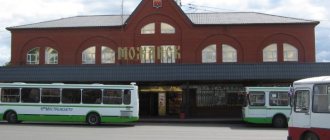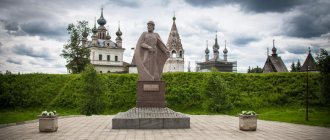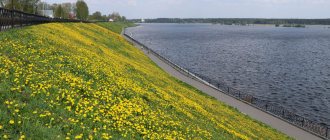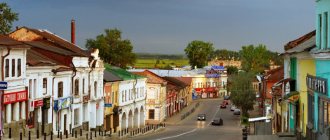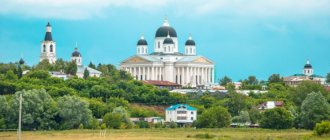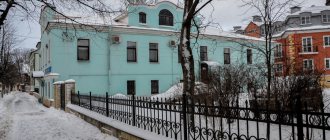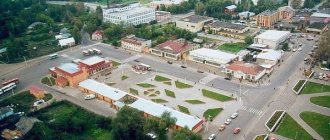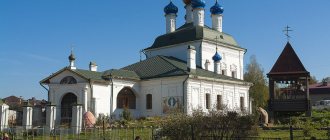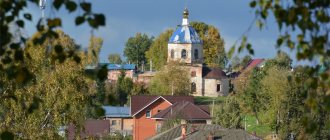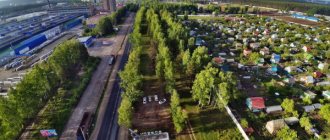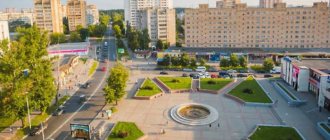Countries > Russia
Kostroma is one of the most unusual points of the Golden Ring. Each historical era has greatly changed its appearance, so now it is a city of contrasts with ancient monasteries, merchant mansions and Soviet buildings. In addition, there are many interesting museums and architectural monuments in the center and surrounding areas. What is worth visiting during your visit is in this post.
- Sights of Kostroma
- Neighborhood
- Museums
- Map
In the center
Shopping arcades
The shopping arcades are reminiscent of the former heyday of Kostroma as a center of merchants and trade in the 18th century. Walking under the arched vaults with dozens of benches, it is easy to imagine what the rows - or Gostiny Dvor - looked like at that time, because their appearance has remained virtually unchanged. Now Kostroma souvenirs, products of local farmers and artisans are sold here. There is a market inside during the daytime.
The complex is also interesting from an architectural point of view. The project considered the area of each merchant store and the arched entrance to them. A similar design of rows has been preserved in Uglich.
st. Red Rows, 1
Working hours: 10:00-19:00
Free admission
Church of the Savior in Rows
The dominant feature of Gostiny Dvor is the five-domed church of the 18th century in the pre-Petrine style. The temple fits harmoniously into the architectural ensemble of rows and complements the composition. During Soviet times, an anti-religious museum was located inside, and part of the bell tower was dismantled. Then the premises were used as a warehouse for a long time, and only in the 1990s was it returned to the Russian Orthodox Church and restored to its original appearance.
st. Red Rows, 1
Susaninskaya Square
All main streets diverge from the central square - Susaninskaya, named after Ivan Susanin, who was a Kostroma resident. There is a monument in his honor in the square.
The streets radiating from the square resemble a fan, and this layout makes it easy to navigate the center. On the main streets you will find many architectural monuments from different historical eras. At the same time, the square itself is rich in historical buildings.
Fire Tower
It is impossible not to notice the tallest building and symbol of Kostroma - the Fire Tower. Once upon a time, it delighted Nicholas I, who even regretted that there was no such tower in St. Petersburg. Until the beginning of the 21st century, it was used for its intended purpose, and now it is a museum-reserve with a historical exhibition. Similar projects can be found in other cities, for example, in Uglich.
Borschov's House
Also attracting attention is a large classical building - the Borschov House. It is difficult to imagine that such a monumental building was originally built as a residential estate. The emphasis is on the facade with an eight-column portico, which fits into the composition of Susaninskaya Square. In the 19th century, when Russian emperors and writers came to the city, they stayed there, including Zhukovsky.
Wiki/Commons
Guardhouse
The architectural ensemble of the Guardhouse Square is also completed in the style of late classicism. Previously, a guard was located here and until the beginning of the 20th century the building served its original purpose. Now it is occupied by a branch of the Kostroma Museum.
Central Park
The Kostroma Kremlin, which was once the architectural dominant of the historical center, has not survived to this day. Several churches burned down in a fire in the 18th century, and the rest were destroyed in 1934 as part of an anti-religious campaign. Now in its place is a park with a monument to Lenin and an observation deck.
Lenin monument
For the centenary of the House of Romanov, it was planned to erect a monument in his honor on the territory of the Kremlin. However, the revolution of 1917 happened, after which, of course, there could be no talk of any monument to the royal family. They decided to use the pedestal, which was already ready, for another purpose and erect a monument to Lenin on it. The discrepancy in proportions is noticeable even now - the pedestal and the monument obviously do not suit each other.
Now, from the other side, the panorama without the Kremlin seems incomplete, especially when comparing the current view with historical photographs. Work is currently underway to restore some churches of the former Kremlin, so part of the historical appearance will be recreated.
There is an observation deck in the park, which offers a beautiful view of the Volga and the embankment.
Working hours: 10:00-21:00
Free admission
Soviet street
Sovetskaya Street is the main street in the city; it runs through all the main areas from the bus station and railway station to Susaninskaya Square. Since the street crosses the entire Kostroma, it contains the most striking contrasts in the development. It preserves wooden residential houses, merchant mansions in the Art Nouveau style, ancient churches, and Soviet minimalist buildings.
Closer to the square there are good examples of Art Nouveau with characteristic expressive decor.
Also, most cafes and shops are concentrated on Sovetskaya Street.
Simanovsky Street
Another ray extending from Susaninskaya Square is Simanovsky Street. Perhaps this is one of the few places in Kostroma where the atmosphere of the ancient city has been preserved. There are no modern buildings on it, so it’s easy to imagine what it looked like several centuries ago.
Among the surviving monuments: Stozharov's house, Tretyakov's houses and other merchant mansions.
Route
What to see in Kostroma in 1 day? The route should start from the city center - from Susaninskaya Square . After examining the architectural ensemble of the main square of the city, go to the Central Park - to the place where the Kostroma Kremlin . After resting in the park and returning to Susaninskaya Square, move along Mira Street - important architectural objects of the city are located here: the Assembly of the Nobility , the Drama Theater , the Durygins' estate .
The second half of the route of 1 day in Kostroma will look like this: Epiphany-Anastasia Monastery - Ipatiev Monastery - Museum of Wooden Architecture "Kostroma Sloboda" . The route, despite the short distance between the objects, is quite eventful. You can get around all the listed sites in 3-4 hours - but this is without visiting the attractions inside. For a more thoughtful acquaintance with the sights of Kostroma in 1 day, it is worth setting aside at least 5–6 hours.
Monument to Susanin Photo: © Alexey Panin
Wooden architecture
To see the amazing carved decor and platbands of wooden houses, be sure to take a walk along Shagova, Sennaya and Engels streets. Over time, architectural monuments and wooden decor are becoming more unique and rare, so wherever this heritage has been preserved, you should try to visit such neighborhoods.
In addition to wooden houses, Kostroma has many red brick buildings from the early 20th century. The outskirts are built up with Soviet panel houses and new high-rise buildings.
Monument to Yuri Dolgoruky
Address: Voskresenskaya (Sovetskaya) square
The monument was erected in honor of the 850th anniversary of the founding of the city. This is a large bronze sculpture more than 4 meters high, standing on Resurrection Square. At its base is a capsule with soil from the burial place of the prince, the Kiev Pechersk Lavra complex, and the Church of the Savior on Berestov.
The monument depicts the prince sitting on a throne wearing a Monomakh hat and holding a sword in his hand. The four-ton sculpture was unveiled on August 29, 2002, the day of the Icon of the Feodorovskaya Mother of God, patroness of Kostroma.
Neighborhood
Holy Trinity Ipatiev Monastery
Not far from the center there is an ancient monastery, very important from a historical point of view. Firstly, once upon a time it was within its walls that the Ipatiev Chronicle was found - one of the oldest documents and sources of information about ancient Rus'.
Secondly, the Ipatiev Monastery was captured by False Dmitry II and even turned into a real armed fortress.
Thirdly, it was here that the Time of Troubles was put to an end, through a ritual for the reign of Mikhail Romanov. Due to this, it is considered an important place in the history of the Romanov dynasty. Museum exhibitions located in the monastery premises will tell you more about the history.
Photo from Wikipedia.
st. Prosveshcheniya, 1
Time: 09:00-17:30
Entrance: 150 rub.
Kostroma Sloboda
Near the monastery there is another interesting point - the Ethnographic Village, which recreates peasant life and stores important household items of that time. The museum-reserve also stores important architectural monuments transported here from territories flooded during the creation of the Gorky Reservoir.
Znamensky Monastery
While other Kostroma monasteries are popular among tourists, the Znamensky Monastery rarely makes it onto tourist routes. That is why it is worth coming here for the real atmosphere of monastic life, peace and quiet. It is surprising that the monastery was founded relatively recently and unites two ancient churches - the Resurrection of Christ and Znamenskaya.
The Church of the Resurrection of Christ on Debra deserves special attention. The five-domed composition is surrounded by galleries with hipped porches, and next to it is the Holy Gate with two expressive arches and rich decoration. Previously, the facade was decorated with bright paintings and decorative details, but, unfortunately, all of them have not been preserved.
Wiki/Commons
st. Nizhnyaya Debra, 37
Time: 08:00-17:00
Free admission
Elk farm
The Sumarokovskaya farm is a rare place with domesticated moose, which you can feed and take pictures with. You will have to get to the farm yourself by car or with a tour.
village Sumarokovo
Time: 10:00-15:00
Entrance: 100-150 rub.
Nearby cities
In the neighborhood of Kostroma there are many interesting places where you can go for one day: Yaroslavl, Ivanovo, Bui. In addition, the region has many ancient towns with a rich history, for example, Nerekhta and Krasnoe-on-Volge.
How to get there
The most trouble-free way seems to be a train trip. “Swallow” from the Yaroslavl station in the Russian capital covers the distance in just over 4 hours, a ticket costs about 1,000 RUB one way.
There is also a direct night train from Moscow to Kostroma every day. He sets off at 11:30 pm and arrives at 5:30 am. It costs more, but you will arrive at your destination fresh and rested. And you will go to meet the dawn together with the city.
There is also a direct train from St. Petersburg to Kostroma. True, not every day, once a week on Thursdays. It departs at 19.50 from the Ladozhsky station and arrives at the Kostroma-Novaya station 18 hours and 17 minutes later. That is, in the middle of the day. A reserved seat ticket costs from 1,800 RUB.
Many tourists will probably be inspired by a weekend trip from Moscow. Although it will take about 5 hours to cover the 350 km distance between cities, it is possible to construct a non-stop route. For example, visit Pereslavl-Zalessky and make a thorough stop in the capital of the Golden Ring.
And then it may well come in handy to get to the cozy and literally toy-like Plyos. The town on the Volga, which glorified Isaac Levitan. However, it may very well be the other way around
To get to Kostroma by car, first you need to take the M8 Kholmogory highway. And after Yaroslavl go to the right, onto the regional P600.
© Eurotraveler.ru
Museums
Historical
The exhibition is located on the first floor of the Fire Tower on Susaninskaya Square. The museum will introduce you to the history of the city and region.
Wooden architecture
It is located not far from the Ipatiev Monastery and consists of unique centuries-old wooden buildings. In addition to the exterior wooden decor, the buildings and churches have restored historical interiors and furniture.
Wiki/Commons
st. Prosveshcheniya, 1B
Time: 09:00-17:00
Entrance: 100-150 rub.
Flax and birch bark
The exhibition will tell about the ancient origins of the use of flax and birch bark, the cultural traditions of the region and the country as a whole associated with these materials.
st. Tereshkova, 38
Time: 09:30-17:00
Entrance: 50-100 rub.
Nature of the Kostroma region
The museum's dioramas will show the diversity of nature and animals. Reconstruction of scenes from the animal world and a petting zoo will be of interest to both adults and children.
st. Milk Mountain, 3
Time: 10:00-18:00
Entrance: 80-120 rub.
Sightseeing tours
Getting to know a city with a long history is always more interesting with local residents. Guides from Kostroma will take you not only to the top attractions, but also to places hidden from the mass tourist. You can order an introductory walk around Kostroma or, after exploring the city on your own, purchase a thematic excursion: for example, to the Ipatiev Monastery.
Excursions around Kostroma on the project Experts.Tourister.Ru
Museum of Wooden Architecture Photo: © Eduard Skvortsov
Where to stay
Kostroma has quite a large selection of accommodation, including budget hostels, good hotels, and private apartments. It is better to choose housing in the center, since the difference in price will be small and you will not have to waste time on the road.
It’s easier to choose the right option in the Hotellook aggregator, since the prices of all popular search engines, including Booking, are immediately presented there.
Private housing, including apartments and houses in the region, is more convenient on Sutochno.ru in Kostroma
Stories, routes and tips from tourists with photos
Answer to the question: “What to see from the sights of Kostroma in 1 day?” It’s worth looking in the reviews of tourists. Travelers advise how to rationally allocate time, what is worth seeing first. With the help of tourist reports, you can adjust your personal route or take a ready-made plan for a walk around the city.
- "Kostroma. Say: sy-y-r! The New Year's trip (01/03/2020)" - a story about a trip to Kostroma from Ena.
- “Gallop along the Golden Ring. Kostroma" - report from Valeria Belousova.
- “And in my Kostromushka...” - photo album from Svetlana Aubekerova.
- “One day in Kostroma” - a story from Yulia.
All reviews about trips to Kostroma
Shopping arcades Photo: © Alexey Panin
Weather, best time to travel
The temperate continental climate of Kostroma is the reason why fluctuations from -80C to +170C are recorded throughout the year, the wind is moderate, and the average humidity is 76-80%. The coldest month of the year is January , when there are frosts and clear days are rare. The above-zero air temperature starts in April; by June the air warms up to +150C.
Summer in the city is not hot, on average +15-170C. The sun shines often, it rains rarely. September is still warm, and in October climate autumn sets in, the air cools down to +40C, and it often rains.
The first snow falls in November, becoming densely covered by December. Cloudy, frosty winter days seem colder due to the piercing humidity, which in winter is 80-86% with a wind speed of 3.5 m/s.
